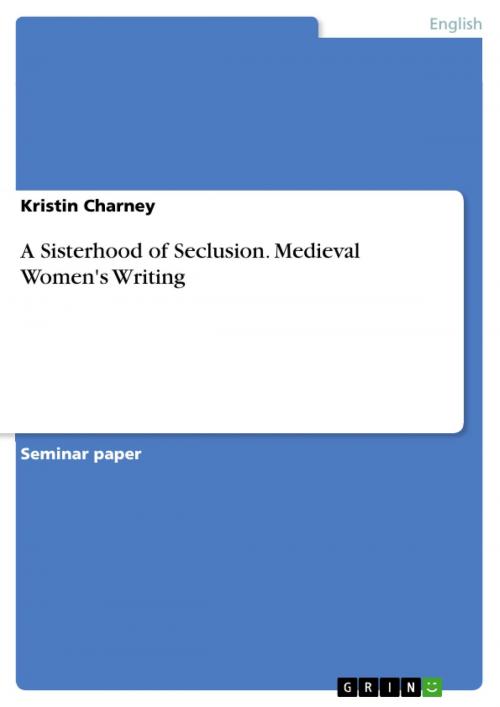A Sisterhood of Seclusion. Medieval Women's Writing
Fiction & Literature, Literary Theory & Criticism, British| Author: | Kristin Charney | ISBN: | 9783656953272 |
| Publisher: | GRIN Verlag | Publication: | May 4, 2015 |
| Imprint: | GRIN Verlag | Language: | English |
| Author: | Kristin Charney |
| ISBN: | 9783656953272 |
| Publisher: | GRIN Verlag |
| Publication: | May 4, 2015 |
| Imprint: | GRIN Verlag |
| Language: | English |
Seminar paper from the year 2012 in the subject English Language and Literature Studies - Literature, , course: English, language: English, abstract: Religious women writers have never been fully recognized for the enormous contribution they made to modern feminism. By looking at religious texts, we can identify that these women have made a literary difference with their proto-feminist texts. It is currently accepted within Women's Studies and other gender-related studies that feminism is divided into three distinct waves. These waves are divided according to their respective time periods, shifts in ideologies, and sociopolitical change. First-wave feminism, infamous for the battle for women's suffrage and changes to marriage laws, was followed in the 1960s by the second-wave: a period dedicated to political activism, and a period that spawned the emergence of Marxist feminism, liberal feminism, and socialist feminism. The third wave was a realization and embracement of different cultures and classes of women, and resulted in the expansion of the definition of feminism. While the method of dividing the periods of feminism into waves is effective, it is also restrictive when taking into consideration the catalyst (or catalysts) for modern feminism. Scholars embarking on their journey in Women's Studies or other related courses are readily introduced to the most graphic images of feminism: pioneers for women's suffrage being hauled off to prison, radical feminists yelling during the most extreme of riots, and visibly distressed and conflicted career women. Students simultaneously become well versed with a unique feminist lexicon, a vocabulary full of caustic words such as 'castration,' 'gender discrimination,' and 'pornography.' In addition to the infamous images and feminist terminology, scholars are also introduced to some highly palatable literature. English classes focusing on women's literature familiarize students with a variety of late Victorian classics, such as Kate Chopin's The Awakening and Gilman's The Yellow Wallpaper, before cautiously entering the increasingly complex realm of Virginia Woolf and Betty Friedan. More specialized courses focus on earlier works, and occasionally investigate the relevance of the 'birth' of feminism by reading Wollstonecraft and Mary Astell. Yet women's studies and women's literature courses, while educational and highly informative, largely fail to consider the earliest of women's movements.
Seminar paper from the year 2012 in the subject English Language and Literature Studies - Literature, , course: English, language: English, abstract: Religious women writers have never been fully recognized for the enormous contribution they made to modern feminism. By looking at religious texts, we can identify that these women have made a literary difference with their proto-feminist texts. It is currently accepted within Women's Studies and other gender-related studies that feminism is divided into three distinct waves. These waves are divided according to their respective time periods, shifts in ideologies, and sociopolitical change. First-wave feminism, infamous for the battle for women's suffrage and changes to marriage laws, was followed in the 1960s by the second-wave: a period dedicated to political activism, and a period that spawned the emergence of Marxist feminism, liberal feminism, and socialist feminism. The third wave was a realization and embracement of different cultures and classes of women, and resulted in the expansion of the definition of feminism. While the method of dividing the periods of feminism into waves is effective, it is also restrictive when taking into consideration the catalyst (or catalysts) for modern feminism. Scholars embarking on their journey in Women's Studies or other related courses are readily introduced to the most graphic images of feminism: pioneers for women's suffrage being hauled off to prison, radical feminists yelling during the most extreme of riots, and visibly distressed and conflicted career women. Students simultaneously become well versed with a unique feminist lexicon, a vocabulary full of caustic words such as 'castration,' 'gender discrimination,' and 'pornography.' In addition to the infamous images and feminist terminology, scholars are also introduced to some highly palatable literature. English classes focusing on women's literature familiarize students with a variety of late Victorian classics, such as Kate Chopin's The Awakening and Gilman's The Yellow Wallpaper, before cautiously entering the increasingly complex realm of Virginia Woolf and Betty Friedan. More specialized courses focus on earlier works, and occasionally investigate the relevance of the 'birth' of feminism by reading Wollstonecraft and Mary Astell. Yet women's studies and women's literature courses, while educational and highly informative, largely fail to consider the earliest of women's movements.















